Are you seeking a new, challenging exercise to add to your workout routine? Look no further than the Renegade Row.
This dynamic exercise targets multiple muscle groups, including the upper back, shoulders, and core, to build strength, stability, and balance.
The Renegade Row is a compound movement involving weights and a plank position to challenge your body in new ways.
It’s time to take your fitness game to the next level with this powerful exercise. Get ready to feel the burn and see the results.
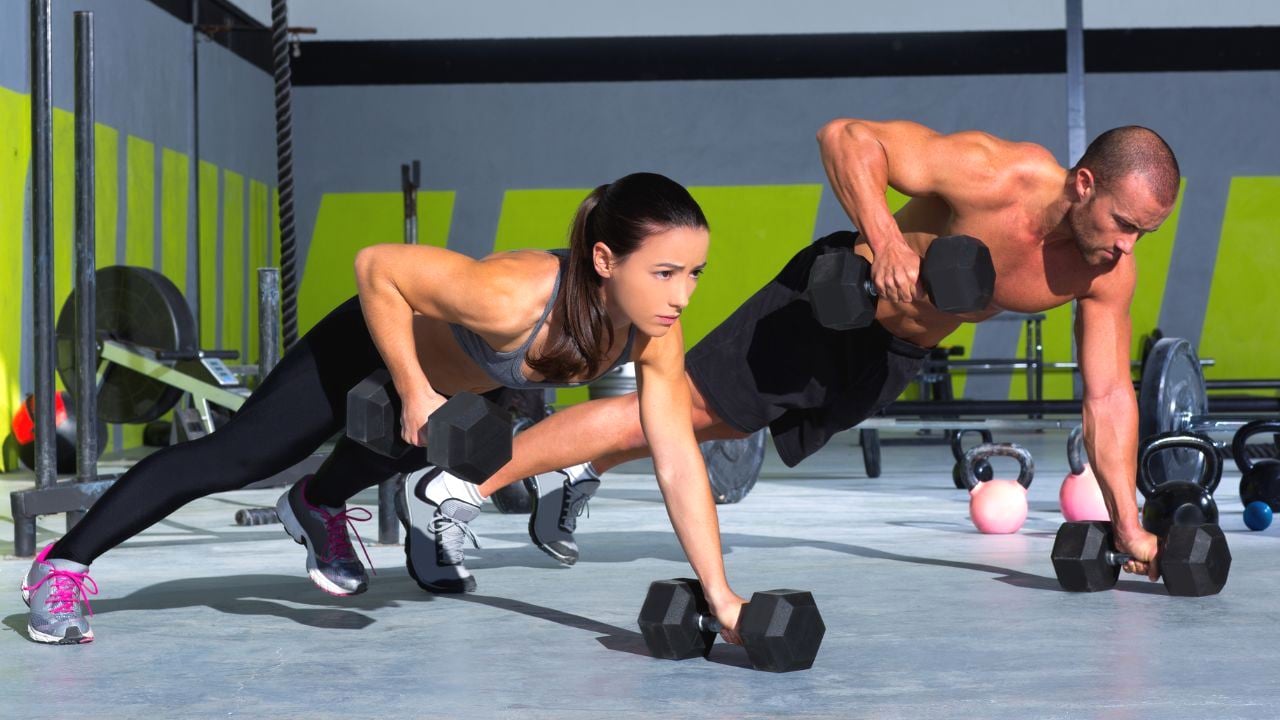
- What is the Renegade Row Workout?
- Muscle Worked During Renegade Row
- How To Do Renegade Row Correctly
- Sets and Reps
- Tips and Techniques for Doing Renegade Row
- 1. Start with Proper Warm-up
- 2. Don’t Round The Lower Back
- 3. Keep Control of The Weights
- 4. Progress Slowly
- 5. Focus on Muscle Engagement and Breathing
- 6. Avoid Lifting Hips Too high
- 7. Keep Elbows Close To your body
- Variations of the Renegade Row
- 1. Knee Renegade Row
- 2. Renegade Row Push Ups
- 3. Kettlebell Renegade Row
- 4. Incline Renegade Row
- 5. Single-Arm Renegade Row
- 6. Renegade Row with a Twist
- 7. Renegade Row with a Leg Lift
- 8. Resistance Bands Renegade Row
- 9. Elevated Renegade Row
- Incorporate Renegade Row Into Your Workout Routine
- Sample Workout Routine
- How To Progress With The Exercise
- Benefits Of Renegade Row
- FAQs
- What Muscles Does the Renegade Row Work?
- Are Renegade rows good for abs?
- What weight should I use for the renegade row?
- Takeaways
What is the Renegade Row Workout?
The renegade row is a full-body exercise that targets the primary muscle groups of the back, shoulders, and core while also engaging the triceps, biceps, and legs.
It is a variation of the traditional plank exercise, which adds resistance by incorporating a dumbbell rowing movement.
Whether you’re a beginner or an experienced exerciser, Renegade Row is a great addition to your workout.
It can be done with dumbbells, kettlebells, or even a pair of water bottles.
It can be modified by using different equipment, different tempos, different loading, different variations of the row, etc.
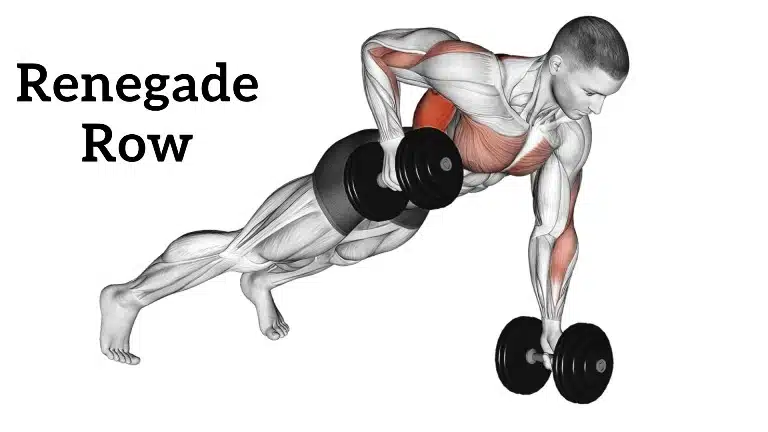
Muscle Worked During Renegade Row
The renegade row is an exercise that targets multiple muscle groups, including:
They primarily work the Back, chest muscles (pectoralis major and minor), triceps, and shoulders (deltoids).
Additionally, they work the core muscles, the serratus anterior, which help to keep the body stable during the exercise.
Furthermore, it is worth mentioning that the legs and glutes are indirectly targeted during renegade row.
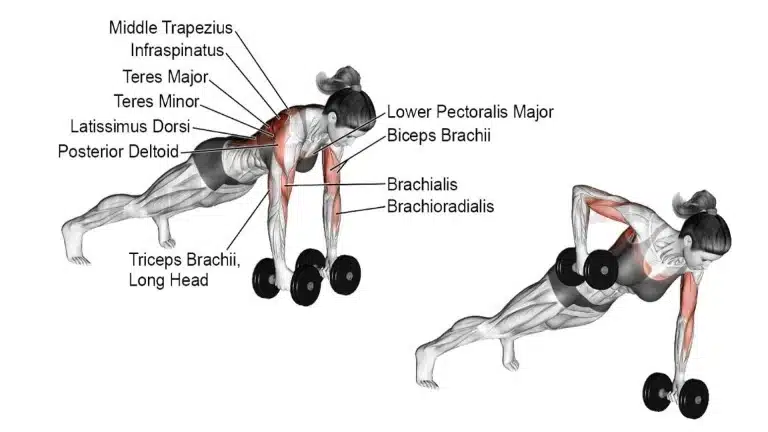
Here’s How These Muscles are engaged:
- Upper back: The row portion of the exercise specifically targets the upper back muscles, such as the rhomboids and the rear deltoids.
- Shoulders: the front and side deltoids are also heavily engaged during it. They work to stabilize the shoulder joint and lift the weight.
- Core: The core muscles, including the abs, obliques, and transverse abdominis, work to keep the spine stable and prevent the hips from sagging.
- Triceps: It works to extend the elbow joint during the row.
- Biceps: It assists the triceps and shoulders during the row
- Legs: mainly the glutes and quads, work to maintain a stable plank position.
- Scapular stabilizers: The small muscles that attach to the shoulder blades (scapulas) are vital in keeping the shoulder blades stable during the exercise.
How To Do Renegade Row Correctly
The renegade row is a challenging exercise that requires proper form and technique to maximize its benefits and prevent injury.
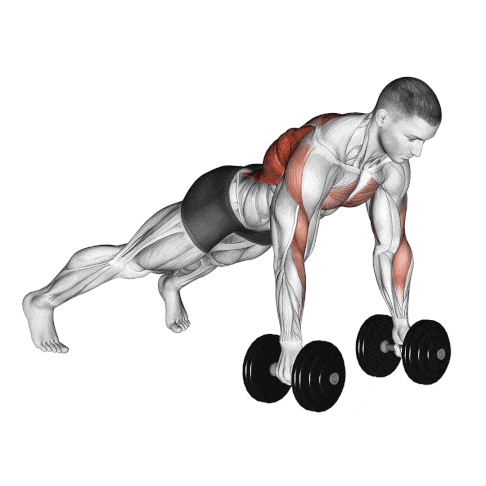
Here’s a step-by-step guide on how to perform the exercise properly:
- Start by positioning yourself in a plank position with a pair of dumbbells placed on the floor underneath your shoulders.
- Your hands should be in a neutral grip position, with your palms facing each other.
- Engage your core and maintain a neutral spine by squeezing your glutes and keeping your hips level.
- Your body should form a straight line from head to heels.
- Begin the exercise by rowing one dumbbell up to the side of your chest.
- Keep your elbow close to your body. And try to squeeze your shoulder blade toward your spine as you lift the weight.
- Lower the dumbbell back down to the starting position.
- Keep your elbow close to your body and maintain your plank position.
- Perform the row with your other arm; this completes one repetition.
- Repeat for the desired number of repetitions.
- Try to keep your hips steady and maintain a stable plank position throughout the exercise.
Maintaining proper form and engaging your core throughout the exercise is important to maximize its benefits.
Sets and Reps
The number of sets and reps for the renegade row exercise will depend on your fitness level and goals.
Here are some general recommendations for sets and reps for different goals:
- For muscle endurance: 2–3 sets of 12–15 reps with a light to moderate weight.
- For muscle strength: 3–5 sets of 6–8 reps with a moderate to heavy weight.
- For muscle hypertrophy (muscle growth): 3–4 sets of 8–12 reps with a moderate weight.
It’s important to note that these are general guidelines and that your specific needs and goals may vary.
Additionally, it’s important to gradually increase the weight over time to challenge your muscles and avoid plateaus.
It’s also important to vary your routine over time to challenge your muscles in different ways by varying rep range sets or introducing different variations of the renegade row.
Tips and Techniques for Doing Renegade Row
Here are some tips and techniques to help you perform it correctly and safely:
1. Start with Proper Warm-up
Do a proper warm-up before doing it.
A warm-up will prepare your body for the exercise by increasing blood flow to your muscles and joints.
2. Don’t Round The Lower Back
When performing the renegade row, it’s important to maintain a neutral spine position to avoid rounding the lower back.
To avoid this, engage your core muscles and keep your hips. Keep your core tight your body in a straight line, and maintain proper form.
3. Keep Control of The Weights
Make sure to keep control of the weights throughout the exercise, avoiding swinging or throwing the weights during the rowing motion.
Using too heavy of a weight can cause you to lose proper form, which can lead to injury.
It’s important to use weights that you can handle to avoid straining your muscles.
4. Progress Slowly
Start with only your body weight before adding weights.
As you progress, you can increase the weights or reps to make the exercise more challenging.
5. Focus on Muscle Engagement and Breathing
When rowing, focus on squeezing your shoulder blade towards your spine, and when pushing up, focus on engaging the chest and triceps.
It’s also important to breathe correctly during the exercise. Inhale as you lower your body, and then exhale as you push back up.
6. Avoid Lifting Hips Too high
This can occur if you use your lower back and hip muscles rather than your upper back and shoulder muscles to initiate the movement.
To avoid this, focus on squeezing your shoulder blades together as you lift the weight.
7. Keep Elbows Close To your body
Not keeping your elbows close to your body can put extra strain on your shoulders and elbows. To avoid this, keep your elbows close to your body when you’re working out.
Also, stretch your muscles after your workout to help reduce muscle soreness and improve flexibility.
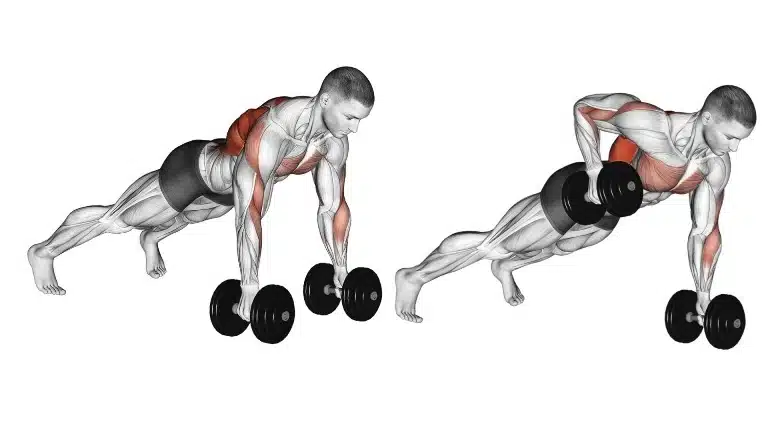
Variations of the Renegade Row
The renegade row can be done differently to suit your fitness level.
If you are new to performing it, you may want to apply a few modifications to make the exercise easier. One way to avoid this problem is to do a renegade row on your knee. Another is to use a lighter weight.
Several variations can enhance your workout results once you have mastered the basic renegade row form.
If you are looking for a more advanced variation to stimulate different muscle fibers, then try kettlebells Renegade Row, and renegade row push up and Renegade Row with a Twist.
1. Knee Renegade Row
The Knee renegade row is a variation of the traditional renegade row exercise that uses your knees instead of your full plank position.
This modification is good for beginners or people who are not yet ready to perform the full renegade row.
It is also a good option for people with balance difficulties who may struggle to maintain proper form in the plank position.
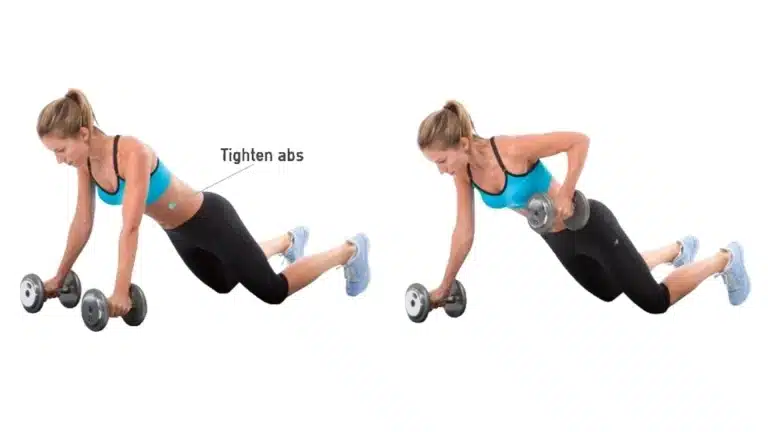
How To Do It
- Start in a kneeling position with dumbbells on the ground in front of you.
- Place your hands on the weights with a shoulder-width grip.
- Engage your core to lift your hips up into a kneeling plank position.
- From this position, row one weight up towards your hip, keeping your elbow close to your body.
- Then, lower it back to the ground.
- Repeat the same movement on the other arm.
2. Renegade Row Push Ups
Renegade row push ups are a compound exercise that combines a push-up with a dumbbell row.
This exercise targets the chest, triceps, shoulders, back muscles, and core.
Additionally, because it works for multiple muscle groups at once, it can be a more efficient exercise for those who are short on time.

How To Do It
- Grip a dumbbell in each hand, positioning them slightly wider than shoulder-width apart.
- Engage your core and keep your body straight as you lower your chest down towards the dumbbells.
- Keep your elbows close to your body as you lower down.
- Once your chest touches the dumbbells, press back up to the starting position, fully extending your arms.
- As you press up, row one dumbbell up towards your chest, keeping your elbow close to your body.
- Lower the dumbbell back down to the ground and repeat the movement on the other side.
3. Kettlebell Renegade Row
The Kettlebell Renegade Row is a great variation; it can be challenging to work on grip strength, upper-body strength, and core stability.
They offer a wider range of motion and different grip options on the handle.
Also, kettlebells can be harder to hold than other types of weights, so the core and stabilizing muscles will have to work harder.
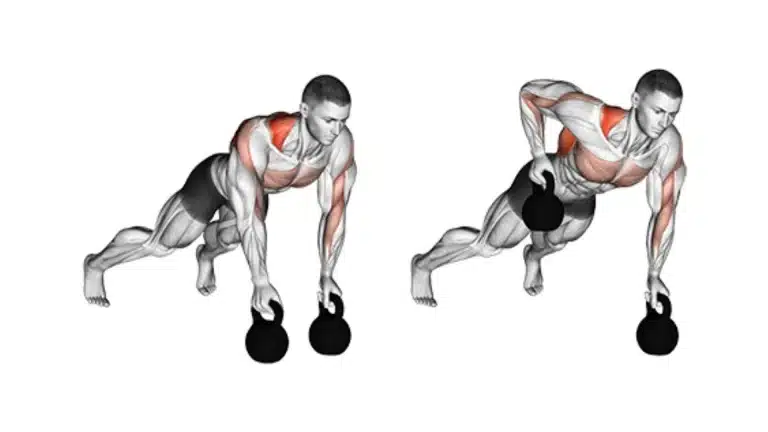
How To Do It
- Start in a plank position with your feet shoulder-width apart and your hands placed on two kettlebells in front of you.
- Engage your core and keep your body straight from your head to your heels.
- Lift one kettlebell off the ground by rowing it towards your hip.
- Keep your elbow close to your body and your chest parallel to the ground.
- Lower the kettlebell back to the ground and repeat the same movement with the other arm.
- Continue to alternate arms, maintaining proper form throughout the exercise.
4. Incline Renegade Row
The Incline renegade row is a variation that involves performing the exercise on an inclined surface, such as an adjustable bench or a step.
It is also a good variation to change your routine and make the exercise more fun by adding an incline.
This variation of the can also target the core and stabilizer muscles more due to the incline angle.
It is also a good way to introduce more load on the shoulders, as the angle also changes the resistance point of the weight.
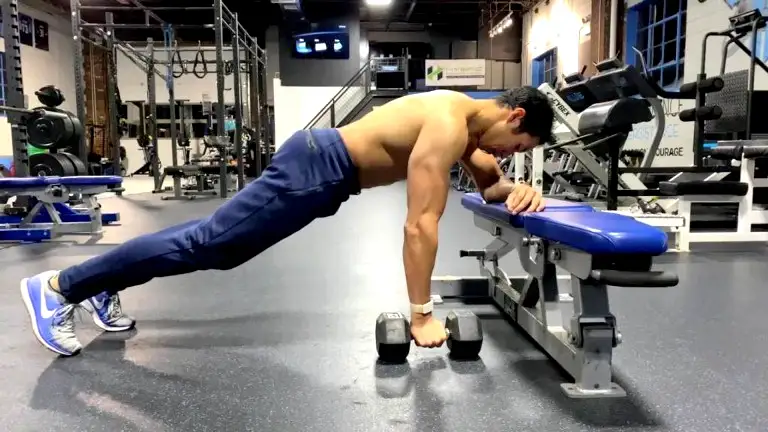
How To Do It
- Start in a plank position with your feet on the ground and a dumbbell on the bench or floor.
- Engage your core and keep your body in a straight line.
- Lift one weight off by rowing it towards the chest.
- Lower the weight back and repeat the same movement with the other arm.
5. Single-Arm Renegade Row
The Single-arm Renegade Row is a challenging variation that can help build unilateral strength and stability.
It can be useful for athletes and anyone looking to improve their symmetry.
This variation involves performing the exercise with only one arm at a time.
It can increase the difficulty level and target the core and upper body muscles even more.
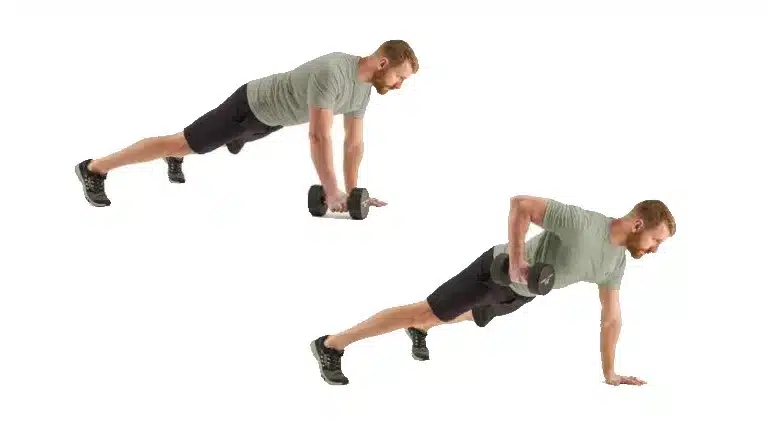
How To Do It
- Start in a plank position with one dumbbell or kettlebell on the ground.
- Start by engaging your core and keeping your body in a straight line from your head to your heels.
- With one hand, grip the weight, keeping your elbow close to your body, and lift it off the ground by rowing it towards your hip.
- Keep your core tight and maintain proper form throughout the exercise.
- Lower the weight back to the ground, then switch arms and repeat the same movement.
6. Renegade Row with a Twist
This variation involves adding a twist to the row movement.
As you row the dumbbell up to the side of your chest, you rotate your torso and twist the weight toward the ceiling.
It targets the same muscle groups as the traditional renegade row, such as the upper back, shoulders, and core, but with an emphasis on the oblique muscles and rotator cuff muscles.
It’s important to maintain proper form and control the movement, twisting only with your torso, not with your hips or legs.
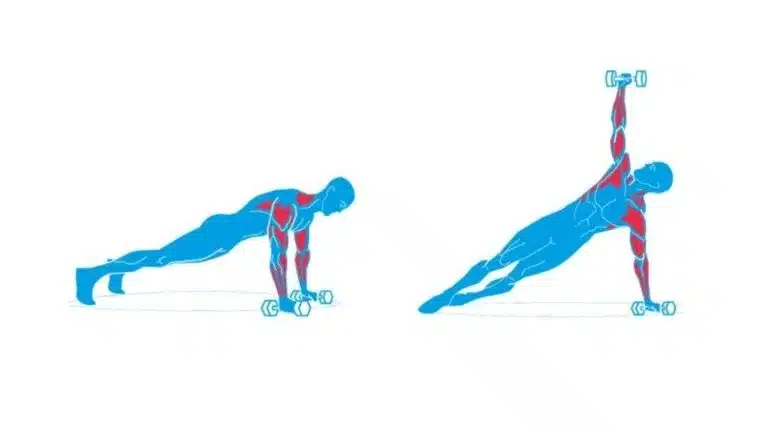
How To Do It
- Start in a plank position with a dumbbell or kettlebell in each hand.
- Your feet are shoulder-width apart, and your hands are placed on the weights.
- Lift one weight off the ground by rowing it towards your hip.
- As you lift the weight, twist your torso towards the same side, rotating at the waist while keeping your hips and legs stable.
- Lower the weight back to the ground and repeat the same movement with the other arm.
- Continue to alternate arms.
7. Renegade Row with a Leg Lift
This variation involves lifting one leg up and away from the ground while performing the row.
This variation can increase the difficulty level and target your glutes and quads.
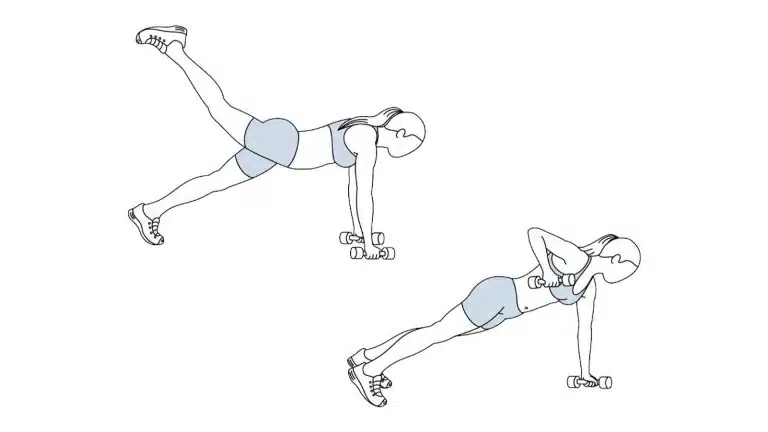
How To Do It
- Start in a plank position with a dumbbell or kettlebell in each hand,
- Engage your core and keep your body straight from your head to your heels.
- Lift one weight off the ground by rowing it towards your hip.
- As you lift the weight, simultaneously lift the opposite leg up towards the ceiling, keeping it straight.
- Lower the weight back to the ground and the leg back to the starting position.
- Repeat the same movement with the other arm.
8. Resistance Bands Renegade Row
The resistance band renegade row variation utilizes a resistance band instead of dumbbells.
This can be a great option for those with limited equipment at home or traveling.
This variation targets the same muscle groups as the traditional renegade row but also emphasizes grip strength more.
How To Do It
- Secure a resistance band to a sturdy anchor point (e.g. a post or a door anchor) and kneel or stand facing the anchor point.
- Hold the band with an overhand grip and step away from the anchor point to create tension in the band.
- Engage your core and keep your body straight from your head to your heels.
- Row one arm at a time towards your hip.
- Lower the band back to the starting position and repeat the same movement with the other arm.
9. Elevated Renegade Row
The Elevated Renegade Row variation will add more core stability and engage the muscles of the legs and glutes even more by exercising with your feet elevated on a bench or step.
It increases the range of motion and can place more emphasis on the core and stabilizer muscles.
This variation can be helpful for people who want to increase the intensity of the exercise or who want to add variety to their routine.
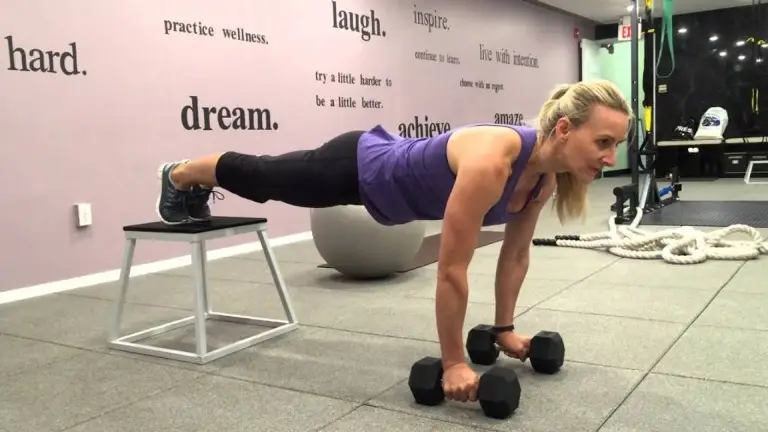
How To Do It
- Start in a plank position with your feet on a bench or step and your hands on two dumbbells or kettlebells on the ground.
- Engage your core and keep your body straight from your head to your heels.
- Lift one weight off the ground by rowing it towards your hip.
- Lower the weight back to the ground and do the same thing with the other arm.
Incorporate Renegade Row Into Your Workout Routine
To incorporate the renegade row into your workout routine, add it as an accessory movement, as a part, and stand-alone.
You should listen to your body and not push yourself too hard too soon.
Here are a few ways you can incorporate the renegade row into your workout routine:
- As an accessory movement: You can add it as an accessory movement after your main exercises like pull-ups or push-ups. For example, if you are doing a workout that includes push-ups, you can finish your set of push-ups with a set of Renegade Rows.
- As part of your core workout: It is an excellent exercise for the core; you can include it in your core workout routine alongside exercises like planks, leg raises, or Russian twists.
- As part of a full-body workout: This can be added to a full-body workout routine after exercises that target your upper body, legs, and core.
- As a standalone workout: It can be used to create a workout program by itself. Build a workout routine with progressive sets and reps.
Sample Workout Routine
| Exercise | Sets | Reps/Duration |
|---|---|---|
| Warm-up | – | 5–10 min |
| Pull-ups | 3 | 8–12 reps |
| Push-ups | 4 | 8–12 reps |
| Renegade Row | 3 | 8–12 reps per arm |
| Planks | 3-4 | 30–60 seconds |
| Russian twists | 3 | 12–15 reps |
| Cool down | – | 5–10 min |
*rest 30–60 seconds between each set
How To Progress With The Exercise
Progressive overload is a key principle in strength training; it means gradually increasing the resistance, reps, sets, or weight. Here are a few ways you can progress with the Renegade Row exercise:
- Increase weight: Start with a light weight and gradually increase the weight as you get stronger.
- Increase reps and sets: Start with fewer reps and gradually increase the number of reps per set and no. of sets as you get stronger.
- Incorporate variations: As you get stronger, you can incorporate different variations of the renegade row exercise into your workout routine to keep the exercise challenging. For example, you can try the Single-Arm or Elevated Renegade Row.
- Slow down the movement: You can increase the challenge by slowing down the tempo of the movement. This will increase the time under tension and will recruit more muscle fibers.
Benefits Of Renegade Row
It is a great full-body exercise that provides several benefits for both athletes and fitness enthusiasts.
- Working your upper back, shoulders, and triceps, the renegade row can help to improve your upper body strength. That could lead to improved performance in other exercises and activities.
- The renegade row requires you to maintain a plank position while also performing rows, which challenges your core muscles and improves your overall stability.
- As it requires you to maintain proper form while performing the exercise, it can help to improve your balance and coordination.
- With proper form and technique, the renegade row can help to improve scapular stability. It is important for upper body movement and also beneficial for injury prevention.
- It is a challenging full-body exercise that can help to improve your overall conditioning and fitness levels.
- It is a compound movement involving multiple muscle groups, and it can burn many calories and help lose weight.
- It is a versatile option for people with different equipment availability. It can be done with different types of equipment, like kettlebells, dumbbells, resistance bands, and body weights.
- As it doesn’t require a lot of equipment or space. It’s convenient for people with busy schedules or limited access to a gym.
FAQs
What Muscles Does the Renegade Row Work?
The renegade row works multiple muscles in your arms, chest, back, and core.
Specifically, it targets the lats, triceps, biceps, and chest muscles as you lift the weights up toward your torso.
Plus, it strengthens your deep core muscles to stabilize your body during the exercise.
Are Renegade rows good for abs?
When performed correctly, the Renegade Row can engage the rectus abdominis, obliques, and transverse abdominis, which all work together to provide stability, support, and balance.
While it is not a primary abs exercise, it is an effective compound movement to strengthen the core.
What weight should I use for the renegade row?
- Beginners: If you are new to the renegade row, start with a lightweight pair of 5-8 pounds.
- Intermediate/Advanced: If you have experience and understand the proper form, you can start using heavier weights, such as a pair of 10-15 pound. You can increase weight as you get stronger.
- Remember that your weight should be heavy enough to challenge you but light enough to allow you to maintain proper form.
- Remember that proper form is key. If you cannot maintain proper form while using a certain weight, it may be too heavy for you and you should reduce it.
Takeaways
The renegade row is a great exercise that targets multiple muscle groups, including the upper back, shoulders, and core.
It’s a compound movement that can help improve overall upper body strength and stability.
Adding it to your workout routine can really spice up your workout and make it more challenging.
Remember that proper form and listening to your body are essential for injury prevention and maximizing the benefits of the exercise.
References
- Saeterbakken A, Andersen V, Brudeseth A, Lund H, Fimland MS. The Effect of Performing Bi- and Unilateral Row Exercises on Core Muscle Activation. Int J Sports Med. 2015 Nov;36(11):900-5. doi: 10.1055/s-0034-1398646. Epub 2015 Jul 2. PMID: 26134664.
- Lehman GJ, Buchan DD, Lundy A, Myers N, Nalborczyk A. Variations in muscle activation levels during traditional latissimus dorsi weight training exercises: An experimental study. Dyn Med. 2004 Jun 30;3(1):4. doi: 10.1186/1476-5918-3-4. PMID: 15228624; PMCID: PMC449729.

Manish brings over 10 years of hands-on experience in weight lifting and fat loss to fitness coaching. He specializes in gym-based training and has a lot of knowledge about exercise, lifting technique, biomechanics, and more.
Through “Fit Life Regime,” he generously shares the insights he’s gained over a decade in the field. His goal is to equip others with the knowledge to start their own fitness journey.
